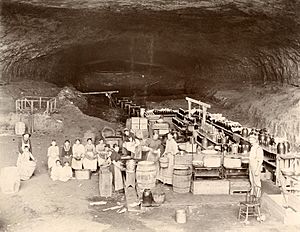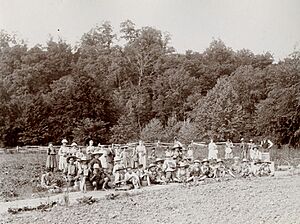Ruskin Colony facts for kids
The Ruskin Colony was a special community in the southern United States. It was a "utopian socialist" place, meaning people dreamed of creating a perfect society where everyone worked together and shared everything. This happened in the late 1800s.
The colony first started near Tennessee City, Tennessee in Dickson County, Tennessee in 1894. It moved to a new farm five miles north in 1896 and stayed there until 1899. Later, it had a short time near Waycross, Georgia in southern Georgia from 1899 until it ended in 1901. Its location in the Southern United States made it different from many other similar communities of that time.
At its biggest, about 250 people lived there. The colony was named after John Ruskin, an English writer who believed in socialist ideas. A cave on the colony's second property in Dickson County is still named after him. The place where the second colony was in Dickson County is now a historical site.
Contents
Starting a New Kind of Community
Quick facts for kids |
|
|
Ruskin Colony Grounds
|
|
| Lua error in Module:Location_map at line 420: attempt to index field 'wikibase' (a nil value). | |
| Nearest city | Dickson, Tennessee |
|---|---|
| Area | 15 acres (6.1 ha) |
| NRHP reference No. | 74001911 |
| Added to NRHP | October 29, 1974 |
The Ruskin Colony was started by Julius Augustus Wayland (1854-1912). He was a newspaper editor and believed in socialist ideas from Indiana. The idea for Ruskin came from a movement in America. People wanted to create new communities that would be different from the busy industrial cities.
These new settlements, like Ruskin, aimed to show a better way of life. They hoped to create a "co-operative commonwealth," which meant a community where people shared everything and worked together for the good of all. This was different from other socialists who thought it was better to organize in cities. In these new places, people hoped to replace the "wastefulness and ugliness" of competition with efficient work and shared wealth.
How the Colony Worked Together
Julius Wayland set up Ruskin so that all members were equal owners, like shareholders in a company. The colony had a group of elected leaders, much like a regular business. But its goal was to "make a success, financially and socially, of a co-operative colony."
The Ruskin colonists made and sold many things. These included pants, "cereal coffee," a special bath cabinet, chewing gum, belts, and suspenders. The way they worked was similar to the outside world in terms of hours. However, the workers themselves decided the hours, schedules, pay, and what industries to focus on. Over time, they stopped using regular money and used a special "scrip" that could only be used to buy things within the colony.
Besides work, members also had time for creative activities like crafts, theater, and learning. At one point, a band from the colony even toured southern Georgia.
Many of the products made in Ruskin helped earn money for the colony's newspaper, The Coming Nation. The newspaper was the main way the colony made money. Most of the colony's time and money went into the paper. In 1896, it had about 60,000 readers! The paper also let the people of the colony share their ideas.
Julius Wayland, who started the colony, left in 1895. This happened because of disagreements about who owned the newspaper. After Wayland left, Alfred S. Edwards took over the newspaper. Later, Herbert Casson became the editor.
The Ruskin colony eventually broke up because of several problems. One big issue was that the first members, called "charter members," had more rights than others. They also had special investment fees. These first members had a lot of control over the colony's leadership and direction.
Moving to Georgia
The colony faced many legal problems over its property. The original "charter members" who were leaving the colony tried to break it up through lawsuits. In the end, most of the colony's shared property was sold. The remaining 240 members were left with very little.
They still had the newspaper and its printing equipment. They moved these items 613 miles on a special train to their new home in Georgia. There, they joined with another group called the Duke Colony and formed the Ruskin Commonwealth.
However, after its first year in Georgia, the number of colonists dropped by half. The new place, an old lumber mill, did not have good land or enough water. The Ruskinites faced sickness, businesses that didn't make money, and a steady slide into poverty. Eventually, the county sheriff sold their property to pay off their debts. The Ruskin Commonwealth officially ended in the autumn of 1901.
A New Start in Florida
The Ruskin Commongood Society later planned out the town of Ruskin, Florida on February 19, 1910.



